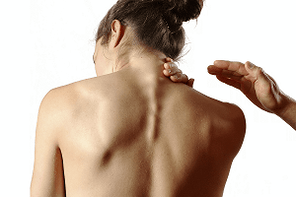
One of the most common degenerative diseases of the spine is the osteochondrosis of the cervical column.This pathology is characterized by a constantly progressive course, during which the patient has serious dyes of the intervertebral discs.
According to statistics, over 45% of adults regularly suffer from constant pain at the neck of the cervical osteochdrosis, which indicates the need to treat it with drugs and other effective methods at home or in a hospital under the supervision of expert specialists.
You can know more about the manifestations and characteristics of the cervical osteocondrosis on numerous patient forums.
Reasons
It should be noted immediately that it is the cervical region in the spine which is the most mobile.They are seven vertebrae, among which they are elastic intervertebral discs.
It is thanks to them that the spine is so flexible.
With the progression of the disease in the human vertebrae, the metabolism is disturbed, which leads to the loss of the elasticity of the disc, their protrusion and cracking.
In the absence of timely treatment, this disease can lead to dangerous complications, including particularly worth highlighting the risk of protrusion.The photos and videos of events of this type of osteochondrosis can be displayed on medical sites and doctors' relationships.
Osteocondrosis of the cervical region in one person is able to develop for various reasons.Very often, the following factors cause it:
- The real way of human life is not enough.
- A poor diet, in which cartilage does not receive enough beneficial substances and becomes more susceptible to degenerative diseases.
- Stay for a long time in an uncomfortable position.
- Rooms in the cervical region.
- The development of serious diseases in the body (gout, rheumatism and the like).
- The presence of a story of the spine.
In addition, the risk of developing this disease increases the individual tendency of a person to the osteocondrosis, severe hypothermia and hormonal malfunctions in the body.
Even often the symptoms of osteochondrosis occur in women during pregnancy.This is justified by an increase in the load on the spine due to the weight gain and the shocking of the bone tissue due to the production of the relaxation hormone.
The care of osteochondrosis is quite difficult.It will be more effective to perform a complete therapy with tablets, gymnastics, therapy for exercises and other treatment methods.
Cervical osteochondrosis: degree of abandonment, classification of the disease and its manifestation
To date, the main degrees of cervical osteochondrosis are distinguished:
- The first degree.In this state, a person develops the first ailments in the spine.The patient gradually begins to disturb periodic pain and a feeling of fatigue in the neck.In X -rays, degenerative changes are practically not expressed.
- The second degreeCervical osteocondrosis is accompanied by a decrease in the space between the vertebrae, due to which they begin to rub each other and cause pain.In addition, for the same reason, the patient has a high risk of pinching the nerve structures.
- The third phaseCervical osteochondrosis leads to the formation of intervertebral hernia, as well as the complete destruction of the structures of the spine.In addition, in this state, the patient in the images clearly sees spinal deformation.
- The fourth phaseIt is rightly considered the most difficult.In this state, the patient is extremely difficult to perform simple movements, because at the same time he feels pain.In most cases, osteochondrosis with this abandonment leads to disabilities.
Osteochondrosis of the cervical column: characteristic symptoms of pathology, methods of diagnosis and principles of therapy
In many ways, as the osteochondosis of the cervical column proceeds, it depends on the cause of the disease, on its degree of abandonment, on the nature of inflammation and bone injuries.
This is important
Dizziness, fainting and a tingling feeling in the shoulder blades are frequent secondary symptoms of progressive osteochondrosis, after which a person should consult a doctor as soon as possible.

Sometimes this disease can cause a person's hearing and vision of a person, constant weakness, heart pain, snoring and pace disorders.
The characteristic signs of the development of osteochondosis of the cervical column are frequent pain in the neck area, which can have an acute, painful, pulling nature or seams.In addition, these pains can be easily administered with hands, shoulders and head.The cough or sneezes can cause another pain attack.
Another frequent sign of osteochondosis of the cervical column is a strong creaking in the neck during the movements of the head.This happens from bone friction due to the deterioration of the state of the cartilage.
Diagnostics
It is very important to correctly establish the diagnosis and differentiate osteochondrosis from other possible diseases of the spine.
That's why a person, in addition to examining the doctor and a story of a specialist on his symptoms, must certainly undergo the following exams:
- Ct.
- X -ray.
- Ultrasound of the cervical region.
- General clinical blood tests.
On the basis of the results, the attending physician will be able to correctly establish a diagnosis and choose a treatment course for each person individually (based on the cause of the disease, his abandonment, the age of the patient and the presence of serious concomitant pathologies in him).
How to treat cervical osteochondrosis: drug therapy, surgery, massage efficiency
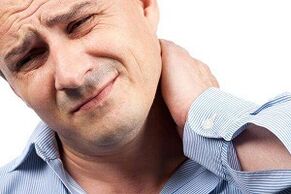
Before treating cervical osteochondosis, it is important for the patient to understand the cause of the development of this disease.It is possible that for this it will need further studies.
Traditional therapy with this diagnosis provides for the compulsory prescription of the medicinal course, with which it will be possible to stop pain, relieve swelling, inflammation and restore the normal functions of the intervertebral discs.
How to treat cervical osteochondrosis also depends on the symptoms observed in the patient.
In this case, traditional therapy provides for the mandatory administration of anti -inflammatory drugs (NSAIDs), as well as steroid drugs.With their help, not only can you get rid of inflammation, but also reduce pain.
Analgesics in the form of tablets are prescribed to eliminate pain.These non -steroidal agents can be both in the form of tablets and having the form of ointment.
To restore the cartilage tissue, chondroprotectors are used.It will take these funds to take these funds for a rather long time to obtain significant improvements.
To facilitate well -being, the patient are prescribed local painkillers.
To relax muscle tone, muscle relaxants are appointed by a person.Due to its therapeutic effect, the intake of these drugs improves blood circulation.
As auxiliary therapy, vitamins of group B, A, C, D and E.
How to correctly treat cervical osteochondosis should be decided by the attending physician.It is strictly forbidden to engage in the car -mediation in this state, because this can even more compromise the well -being of a person.
Surgical treatment
Treatment with the use of surgical intervention is practiced if drug therapy has not achieved the expected results and the disease in a person continues to progress and cause complications.
It is only a leading neurosurgeon who will draw his conclusion after examining the patient and conducted a series of exams that the patient must be decided or not.
In most cases, these patients are removing the intervertebral disc concerned.
Massage and manual therapy
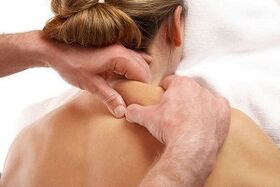
Among the many methods for the treatment of spinal osteocondrosis, one of the most effective methods is rightly considered the professional quality massage.
With its help, you can improve blood circulation, stop pain and fatigue from the neck, improve the mobility of the spine as a whole and also normalize the metabolism.
With a massage course, most patients observe evident improvements and much easier tolerate this chronic disease.
Together with the massage, which provides to caress, knead and rubbing the sick area, the patient is recommended to perform manual therapy.The main thing is a professional approach to treatment, otherwise performed ineptly, therapeutic procedures can do more damage than benefit.
In addition, before performing manual therapy and massage, you absolutely must consult your doctor for contraindications.
Osteochondrosis of the neck: therapeutic gymnastics, dietary nutrition, physiotherapy methods and disease prevention
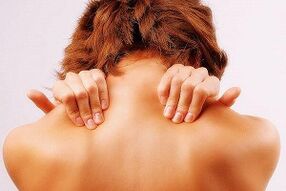
The conduct of operating therapy for osteochondosis of the cervical column will help to strengthen muscles and improve blood circulation.The execution of this gymnastics is the best during the period of remission of the disease, when a person does not feel acute pain.
Practice exercise therapy several times a day.At the same time, all movements should be fluid in order not to damage the spine records and do not cause pain in a person.
The best exercises for the neck are:
- Perform slow head turns on the sides.Repeat 10 times.
- Perform the circular rotation with your head.
- Perform your head and go back.
- Taking your back, get your hands alternatively.
You can perform therapy for exercises or sitting.The back and neck muscles should be in good shape.
Physiotherapy
Physiotherapeutic treatment will be particularly effective in the early stages of osteocondrosis, when the disease has not influenced intervertebral records much.In this state, doctors recommend apply physiotherapy methods such as electrophoresis, magnetotherapy, laser therapy, sounds and mud.
With the help of physiotherapy, you can reduce pain, relieve swelling and inflammation.In addition, these procedures will contribute to the slowdown of the progression of the pathology.
Due to the fact that these treatment methods have many contraindications, only a doctor can prescribe them.
Treatment with popular remedies
You can practice treatment using folk techniques only after the doctor's resolution and therefore, as auxiliary therapy.With caution, the use of these recipes is necessary during pregnancy and breastfeeding, the elderly of a person or the presence of a series of chronic pathologies in him.
The following popular recipes can be used to reduce pain and inflammation:
- Apply a fresh cabbage leaf on the neck at night in the form of a compress.You can also apply honey on it.
- Mix the clay with water in the state of porridge and apply to the neck.Cover with a movie and wrapped up with a hot scarf.
- Rub the neck using honey.
- Pour 2 l.Lilac colors 0.5 l of vodka.It arises for a week and uses a means of rubbing the neck.
- Mix the boiled potatoes with honey and use for hot impatient.
- Mix 2 lemon and the same amount of garlic.Pour the mixture with boiling water and drink the product on a spoon before bedtime.
- Horseback horse and lingonberry horse leaves (1 tablespoon of the mixture for 500 ml of water).Drink half a glass.
- Mix aloe, mustard powder and propolis in equal quantities.The spoonful of the mixture is 1 liter of vodka.Insist and use to compress.
Diet
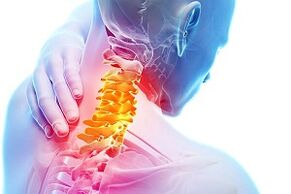
Diet nutrition is mandatory when osteochondrosis is detected.
With his help, a person will be able to saturate his body with useful substances necessary for a faster restoration of the cartilage.
The products recommended in this diet are seafood, vegetables and fruit, low fat and fish meat.Walnuts, dried fruit, dairy products -caseari, eggs, cereals and mushrooms will also be very useful.
A person with osteochondrosis must regularly consume fish and meat broths, a flower and jelly to saturate the cartilage with useful substances.
In turn, alcohol should be completely excluded from the diet in one of its types, spicy, salty, smoked and fat.In addition, you cannot eat salary vegetables, fast food and semifinated products.Under a rigorous ban, sweet carbonated drinks and chocolate.
Staying this power mode should be at least three months.A person needs to eat 5-6 times a day in medium portions.It is also important to drink many liquids, that is to say at least 2.5 liters of water per day.
Complications
The osteochondrosis of the neck is rightly considered the most dangerous type of this disease, since it is in the cervical region that the very important vessels are found with which the brain feeds on.
In addition, in the cervical region, all the vertebrae are strictly adjacent to each other, therefore even a small degenerative change in them can easily cause pinching of the nerve or blood vessels, which threatens of pain, migraine, heart disease, visual damage and heard.
This is important
In advanced conditions, osteochondosis is able to cause spinal stroke, as well as a partial mobility loss.This is the reason why the first treatment is started, the lower the risk of dangerous complications.
Prevention
To reduce the risk of developing osteochondrosis of the neck, doctors regularly recommend engaging in preventive sports.For this, swimming, exercise therapy, yoga and walks in fresh air are fantastic.It is also worth being careful and avoiding acute curves with the head.
In order for the load on the cervical vertebrae is uniform, a person must sleep on a high quality pillow and avoid a long stay on the computer.
Further preventive measures to protect you from the osteochondosis of the neck are:
- A comfortable work chair with an orthopedic back should be selected.
- Take a contrast shower.
- Avoid hypothermia and overload.
- Refuses strong loads in the gym.
- Have a complete diet.
- He leaves bad habits.
- In time to treat those diseases that are able to influence the development of osteocondrosis in humans.

























